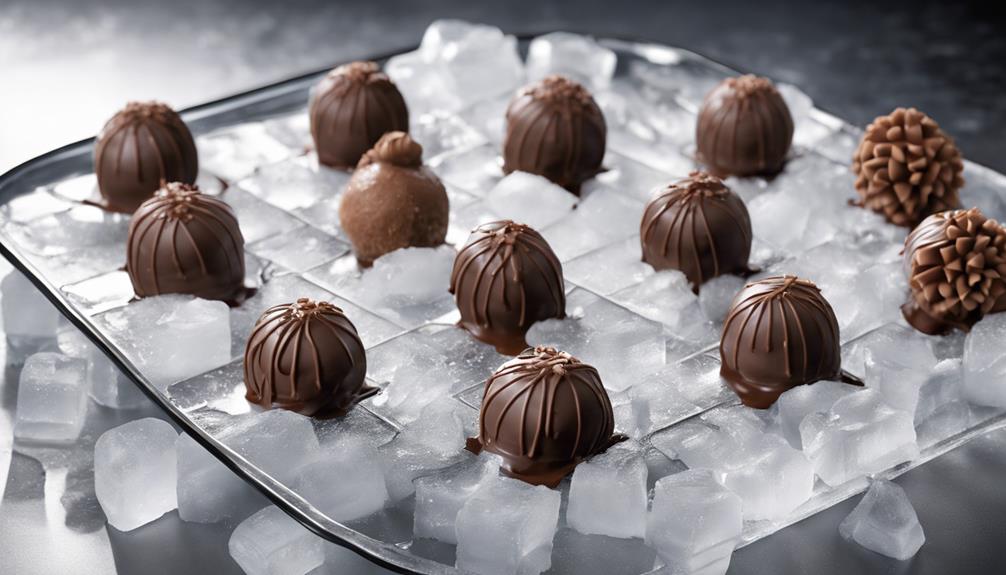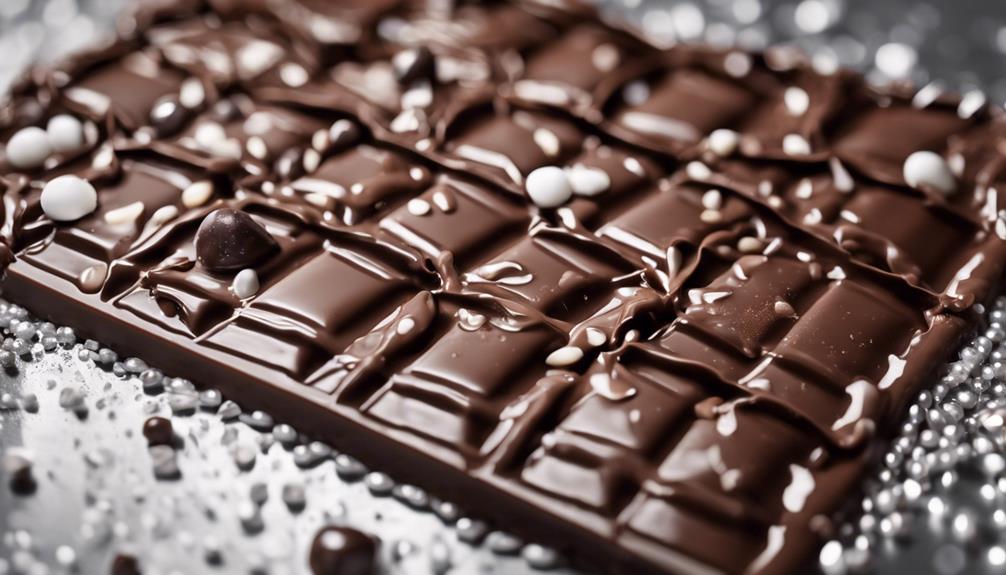To prevent chocolate from melting, store it in a cool, dark place between 50-66.2°F to maintain its shape and texture. Opt for chocolate with a high cocoa content as it helps it remain solid in warm conditions, making it a great choice for desserts that need to hold their form. Avoid exposing chocolate to sunlight as it can accelerate melting, leading to texture loss. Proper wrapping techniques, quick chilling methods, and maintaining the ideal storage temperature are crucial in preserving chocolate. Be mindful of handling chocolate carefully and avoiding overheating during preparation. By following these tips, you can keep your chocolate intact and delicious.
Key Takeaways
- Store chocolate in a cool, dark place to prevent melting and maintain quality.
- Use high cocoa content chocolate for better heat stability and shape retention.
- Avoid sunlight exposure to prevent quick melting and preserve chocolate's structure.
- Properly wrap chocolate to prevent air and moisture affecting texture.
- Utilize insulated containers for transportation to shield against external heat and preserve quality.
Store Chocolate in Cool Place
To prevent chocolate from melting, I always store it in a dark, cool space between 50-66.2°F. This vital temperature range helps maintain the cocoa butter content in the chocolate, ensuring it stays solid and retains its delicious texture. By keeping chocolate in a cool and dry environment, you're safeguarding it against heat damage and preserving its quality for longer periods.
Storing chocolate in temperatures outside the recommended range can lead to undesirable consequences. If it gets too warm, the cocoa butter might start to melt, causing the chocolate to become soft and lose its shape. On the other hand, extreme cold can also affect the chocolate, causing it to develop a whitish coating due to fat streaks. It's important to pay attention to the storage conditions to enjoy your chocolate treats at their best.
Use High Cocoa Content Chocolate

I prefer using high cocoa content chocolate for its superior heat resistance and ability to maintain its shape in warm conditions. High cocoa content chocolate, typically containing at least 70% cocoa, has a higher cocoa butter content, which helps it hold its shape better when exposed to heat. This type of chocolate has a higher melting point, making it less prone to melting even in warm temperatures. Dark chocolate with high cocoa content is especially ideal for hot climates as it stays solid at higher temperatures compared to lower cocoa content chocolates. When making desserts that need to hold their shape in warm conditions, opting for high cocoa content chocolate is a smart choice. Here is a table to highlight the benefits of using high cocoa content chocolate:
| Benefits of High Cocoa Content Chocolate |
|---|
| More stable in heat |
| Higher melting point |
| Maintains shape in warm conditions |
Avoid Direct Sunlight Exposure
Preserving chocolate from direct sunlight is vital to prevent it from melting quickly and maintaining its quality. Direct sunlight can increase the chocolate's temperature, pushing it past its melting point and causing it to lose its shape and texture.
The heat from the sun can alter the taste of the chocolate, making it less enjoyable. Additionally, UV rays in sunlight can speed up the melting process, especially in warmer environments, leading to a messy and unappealing outcome.
To avoid these issues, it's essential to store chocolate in a cool, dark place away from direct sunlight. By doing so, you protect the chocolate's structure and overall quality, ensuring a better experience when you indulge.
Optimal Storage Temperature

Maintaining chocolate at an ideal storage temperature between 50-66.2°F is important to prevent melting and preserve its quality. Temperatures outside this range can cause issues, like chocolate becoming too soft or its structure being altered. It's best to avoid storing chocolate in the fridge or freezer, as this can lead to unwanted texture changes. Additionally, keeping the storage area dry is essential to prevent bacteria growth and fat streaks in the chocolate.
To guarantee the freshness and quality of products containing chocolate, it's vital to follow specific storage guidelines outlined in recipes. By adhering to these recommendations, you can enjoy your chocolate treats at their best. Remember, the key is to maintain a stable and moderate temperature to prevent melting and preserve the delightful taste and texture of your favorite chocolates.
Properly Wrap Chocolate
When wrapping chocolate, make sure it's tightly sealed using aluminum foil, plastic wrap, or parchment paper to protect it from heat and maintain its shape.
- Keep it Secure: Wrap the chocolate bar snugly to prevent air and moisture from affecting its texture.
- Store Your Chocolate Right: Place the wrapped chocolate in a cool, dark place away from direct sunlight.
- Preserve the Crystal Structure: Proper wrapping helps maintain the chocolate's crystal structure, preventing it from melting easily.
- Maintain Flavor Integrity: By sealing it tightly, you keep unwanted odors at bay, preserving the chocolate's delicious taste.
Utilize Insulated Containers

To safeguard chocolate from melting, using insulated containers proves effective in maintaining its temperature during transportation. These containers act as a shield against external heat, keeping your chocolates cool and intact.
Whether you're facing hot weather or starting on a long journey, insulated containers offer a practical solution to prevent melting and preserve the quality of your sweet treats. Available in various sizes and shapes, these containers can accommodate different amounts of chocolate or confectionery, ensuring flexibility based on your needs.
Quick Chilling Techniques

For a swift solution to guarantee chocolate from melting, consider employing quick chilling techniques. When you need to keep your chocolate cool in a pinch, these methods can be a lifesaver:
- Fridge Time: Pop your chocolate in the fridge for short bursts to preserve its shape and prevent it from turning into a gooey mess.
- Melt-Proof Options: Opt for melt-proof chocolate or candy melts that can withstand higher temperatures, ideal for transportation in warm weather.
- Cooler Packs: Seal your chocolate with cooler packs in insulated bags to create a cooling environment that will keep it from melting on the move.
- Freezer Fix: If a fridge isn't available, a temporary stay in the freezer can do wonders to prevent your chocolate from becoming a puddle.
These quick chilling techniques are simple yet effective ways to guarantee your chocolate stays intact and delicious, even when the heat is on.
Avoid Humid Environments

In keeping chocolate from melting, steering clear of humid environments is essential to preserving its texture and appearance.
Humid conditions can cause chocolate to absorb moisture, resulting in a grainy texture and a dull look. Excessive humidity may even lead to sugar bloom, where sugar crystallizes on the chocolate's surface, creating a gritty feel.
To prevent these issues, store your chocolate in a dry place and use airtight containers. High humidity can make chocolate sweat or develop condensation, altering its texture and taste.
To control humidity levels, consider using a dehumidifier or silica gel packs in the storage area. These measures will help protect your chocolate from melting or blooming, ensuring it stays delicious and visually appealing.
Transporting Chocolate Safely

When transporting chocolate safely, it's important to guarantee its protection by sealing it with cooler packs in an insulated bag.
Remember to control the temperature and avoid exposing chocolate to heat sources like car interiors or direct sunlight.
Handling delicate treats with care during transport will help maintain their quality and prevent any melting mishaps.
Packaging for Protection
To guarantee chocolate remains intact while being transported, it's essential to utilize insulated bags with cooler packs for protection. When packaging chocolate for travel, consider these tips:
- Wrap chocolate in aluminum foil or parchment paper to insulate it from heat.
- Avoid leaving chocolate in a hot car to prevent melting.
- Seal chocolate in a plastic bag and place it over ice to keep it cool.
- Protect chocolate from water exposure by using airtight containers.
Temperature Control Tips
Maintaining proper temperature control is essential when transporting chocolate safely. Keeping couverture chocolate between 88-90 degrees Fahrenheit is vital for successful tempering. Dark chocolate typically sets within 2-3 minutes, while milk or white chocolate may take 3-5 minutes during this process. Avoid excessively stirring the chocolate while tempering to prevent crystallization, which can impact the final texture. When setting tempered chocolate, leave it uncovered to prevent blooming and achieve a smooth finish. A helpful tip is to test the tempering by spreading a small amount on paper or a knife to check for the correct setting time. This attention to temperature control and tempering techniques will help guarantee your chocolate arrives in perfect condition.
| Temperature Control Tips | |||
|---|---|---|---|
| Couverture Chocolate | 88-90°F | Proper Tempering | Essential |
Handling Fragile Treats
Handling fragile treats like transporting chocolate safely requires careful planning and specialized tools for maintaining ideal conditions. When it comes to transporting delicate chocolate treats, here are some essential tips to prevent your chocolate from melting and guarantee it arrives intact:
- Use melt-proof chocolate or candy melts designed for hot climates.
- Seal chocolate in an insulated bag with cooler packs to maintain a cool temperature.
- Avoid direct sunlight or heat sources during transportation.
- Opt for short-term freezer storage if refrigeration isn't available.
Prevent Overheating During Preparation

During the preparation process, it's important to take steps to prevent overheating when melting chocolate. To maintain the structure of the chocolate and avoid a grainy texture in your final product, it's essential to handle the melting process with care.
Start by chopping the chocolate into small, uniform pieces. This not only speeds up the melting process but also reduces the risk of overheating. When using the microwave, opt for a microwave-safe bowl and heat the chocolate in short intervals, stirring in between each session to prevent scorching.
Another helpful tip is to grate the chocolate before melting. By breaking it down into smaller pieces, you ensure quicker exposure to heat, facilitating a smoother melting process.
For a more controlled and even melt, consider using a double boiler or bain marie. This method provides indirect heat, helping melt the chocolate evenly and preventing overheating.
Frequently Asked Questions
How Do You Keep Chocolate From Melting Easily?
To keep chocolate from melting easily, I store it in a cool, dark spot around 50-66.2°F. I avoid extreme temperatures and never refrigerate it for long. If traveling to hot areas, I use melt-proof chocolate or cooler packs.
How Do I Make Sure My Chocolate Doesn't Melt?
I keep my chocolate from melting by storing it in a cool, dry spot away from heat and sunlight. I love savoring its rich flavors, so I always make sure to protect it.
What Do They Put in Chocolate to Stop It Melting?
I add cocoa butter, lecithin, and stabilizers like palm oil to chocolate to prevent melting. They help maintain its structure in warm conditions. These ingredients are essential for ensuring my chocolate stays solid and delicious.
How Do Companies Keep Chocolate From Melting?
To keep chocolate from melting, companies use insulated packaging, cool packs, and temperature-controlled vehicles. Advanced cooling systems in storage facilities maintain ideal temperatures. Quality control guarantees chocolate doesn't melt before reaching customers. Specially formulated chocolate with higher melting points is also used.
Can These Chocolate Melting Prevention Tips Also Apply to Raw Cold Food?
When it comes to preventing chocolate from melting, the same tips may not apply to raw cold food. However, it’s important to be aware of the symptoms of raw food eating, such as digestive discomfort and potential foodborne illness. Proper storage and handling are key for both chocolate and raw food to avoid any negative effects.
Conclusion
To sum up, by following these 10 tips, you can prevent your chocolate from melting and guarantee it stays in perfect condition. Remember to store it in a cool place, use high cocoa content chocolate, and avoid direct sunlight exposure.
Properly wrapping and storing your chocolate, as well as taking precautions during transportation and preparation, will help you enjoy your sweet treats without any melting woes. Keep your chocolate safe and enjoy every bite!










